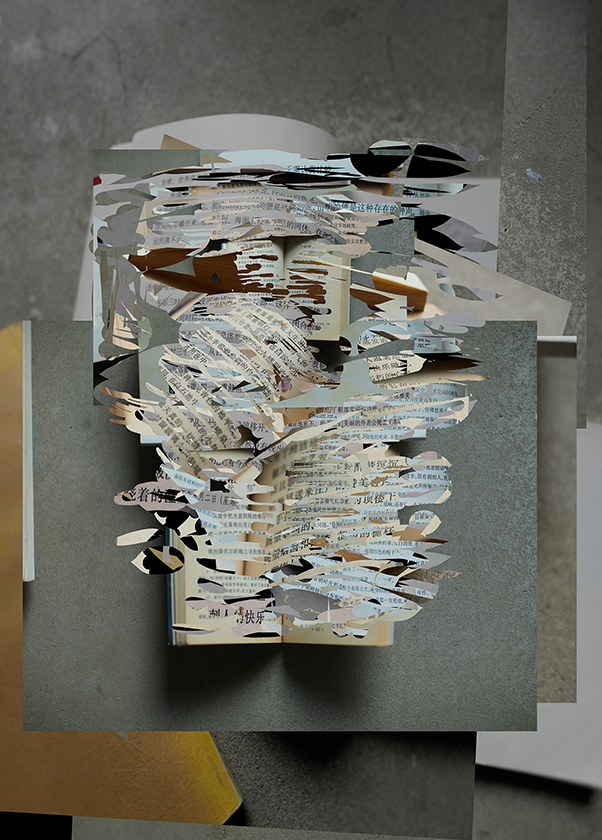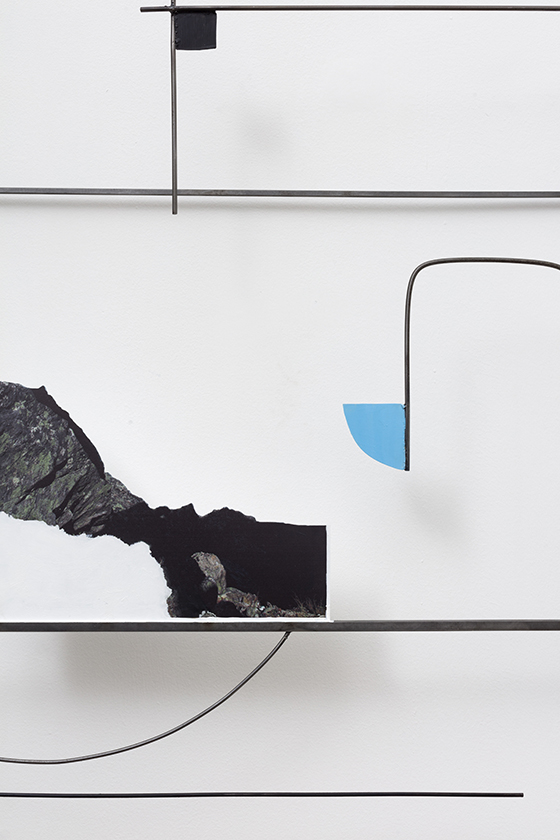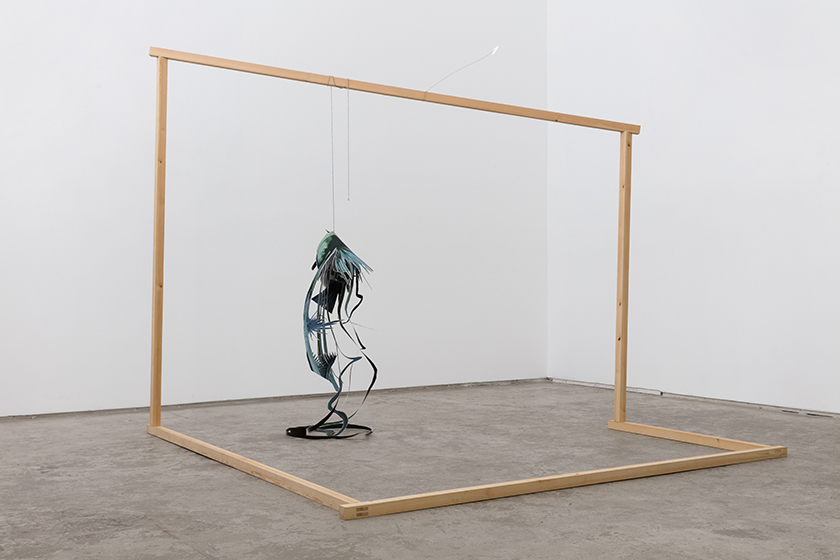





Landscape
hahnemuhle art paper
25*18cm2023

Stone,Sea
metal wire, stainless steel, UV prints, acrylic
138*164*11cm
2023-2024


Stone
marble, cotton twine, wax
marble 12*66*33cmwax 66*16*11cm
2024


Seasonal Breeze
metal, cotton twine, camphor wood, photo paper
H320*D110cm2023-2024


Emissaries
40*18*5cm
2024


Coordinates 1
stainless steel, UV prints, meta
40*40*9cm2024


Coordinates 2
stainless steel, UV prints, meta
40*40*9cm
2024


Coordinates 3
stainless steel, UV prints, meta
40*40*9cm
2024


Coordinates 4
stainless steel, UV prints, meta
40*40*9cm
2024

Pause
bronze,lacquer, handmade candle
H30*D56cm2024

Blank Space
camphor wood, photo paper, metal wire
H220*250*250cm2023-2024



39 Planes
hahnemuhle art paper
88*110cm2024

10:30,Winter
camphor wood,acrylic
230*20*60cm
2024

From Botanical Ferocity to the Realm of the Dispossessed
Meng Xianhui
“You must not, my dear friend, give more importance to Botany than it really has; it is a study of pure curiosity and has no other real use than that, which a thinking sensible being may deduce from the observation of nature and the wonders of the universe," writes Jean-Jacques Rousseau in a letter written in 1770s to a lady revealing his knowledge of botany. Should these words be used in the context of stating art, they may offer a sense of déjà vu despite the verbose rhetoric where the artist's creations are categorized and labeled in various ways. At the same time, their genuine inquisitive essence is obscured in a dense fog.
Fan Xi is often put into the camp of photographic artists, perhaps because her works are often delivered in the medium of photography, and with the opening of her new solo exhibition "Who's Singing" at CLC Ventures, a body of work that defies categorization gradually unfolds. With flickering candles, fluttering threads, and lightweight frames, Fan Xi evokes warmth with a hefty candle. This lighting object embodies various symbolic meanings in various cultural contexts and is, most of all, associated with rituals. Meanwhile, in the gallery, candle produced by the artist never stopped burning, as Pause expresses a connection with familiar scenes in life and the atmosphere of gatherings, the exhibition title offers another layer of imagination through an inquiry.
Since the early phase of her art practice, Fan Xi often emphasized the notion of “production” of her photographs, an ongoing approach allowing her to capture pictures in significant volumes before she filters, observes, superimposes, and processes the images on computer software. Suppose sculpture functions to mobilize the human body and even impact the reception of a work of art through the viewer's experience. In that case, Fan Xi's creative process places this notion in the forefront, like Paul Jackson Pollock's drip and splash paintings, on which the viewer would discover the traces left by the artist and her wandering between photography, painting, and sculpture.
People switch tirelessly between two and three-dimensional spaces, flattening three-dimensional objects on the screen while giving shape to them by using new technologies such as 3D printing; these new approaches seem to resist the way traditional sculptures are viewed, which requires the movement of the body to sense an object’s internal and external changes. In fact, the perceptible and the palpable are still distinguishable. Fan Xi often used intense and long exposures to highlight the traces of her movement in emphasizing the “ferocity” of plants' presence. She explored the "imperceptible" still-life indoors, shot with an overly zoomed-in lens, and soon she began to superimpose the objects she’s captured, extending the images of plants into physical space, showing how an artist's curiosity about creation advances.
In the latest “Landscape," Fan Xi presents the images with the photographs of texts she shot, elusively revealing the Letters on the Elements of Botany (a collection of Rousseau's letters) and some poems. She intentionally blotted out some specific information, leaving only verbal fragments that convey an impression of the narrative, whereas the text's original content is no longer critical. In the artist's view, the narrative-driven writing foreshadows a specific scenario, and the reading experience is akin to wandering in infinite imagination. She renders a rich, three-dimensional space with layers of open books, and what's left unsaid requires the spectator to fill in the blank.
The grasping and commanding sense of distance conveys Fan Xi’s drive to experiment. As one’s vision shifts, the object’s clarity and opacity adjust, and distance makes viewing possible. Fan Xi's representation of an object challenges the notion of the "subject"; the "blank space" places people inside the image, where the form and the spectator's spatial distance are not only limited to the act of viewing. The space uses a frame to assume form, like her use of "paper folding," which eliminates the center of the photograph and leaves only the border. The lightness of the material forces the viewer to control their balance while being mindful of the solidity of the work. The spectator breaks free from the dimensional confines by adjusting their viewing and distance to the object when walking into the picture.
The fragments of cut-out photographs of plants wrapped hang from the frame of Season Breeze, where Fan Xi intentionally scattered them from the folded "sculpture," extending the notion of traces from the past and introducing interaction with the spectators, affording them democratic access. Hence, the lemon derived from the "Untitled" series in Fan Xi's view posits a neutral stance, who gives up on all of the details of the object in an indeterminate manner, contradicting Karl Blossfeldt's close-up photographs of plants with an almost artificial texture.
The four small-dimension works Coordinates 1, 2, 3, 4 are realized in metal, echoing in weight with previous artworks. They define the space as nets without occupying it with their mass, casting like a cage or a nest. Flowers, roads, woods, and waves are imageries of arrival and connection; their winding disposition attributes the artist’s works with power and rhythm. These pieces allow spectators to pause their everyday routine and re-examine the essential relationship between the physical space and the environment, similar to Fan Xi's attention to plants, as we are part of the natural world; art, of course, should be part of it, too. The works with the Chinese character hai (ocean) can be only perceived from one position, negating the three-dimensional feature of a created symbol. Produced in metal and welded onto the whole, Fan Xi renders an uninhabited paradise in space with the other pieces from a mesh of digital computing and urban natural life to allow the spectator to roam around.
As the exhibition's path extends, Fan Xi uses light (in 10:30 Winter) to break through the boundaries between the two galleries physically. The spectator would follow its momentum and look outward, confronting the intangible and formless world in what’s left blank. She invites the spectators to follow the pointer to another indeterminate space, cross the threshold, and experience the other side of the paradoxical space. Thoughts on what the "subject" and who is singing allow Fan Xi to transform the gallery into a perceptual experience that merges time and space, allowing the various elements of photography to shape the structure of a new reality.
